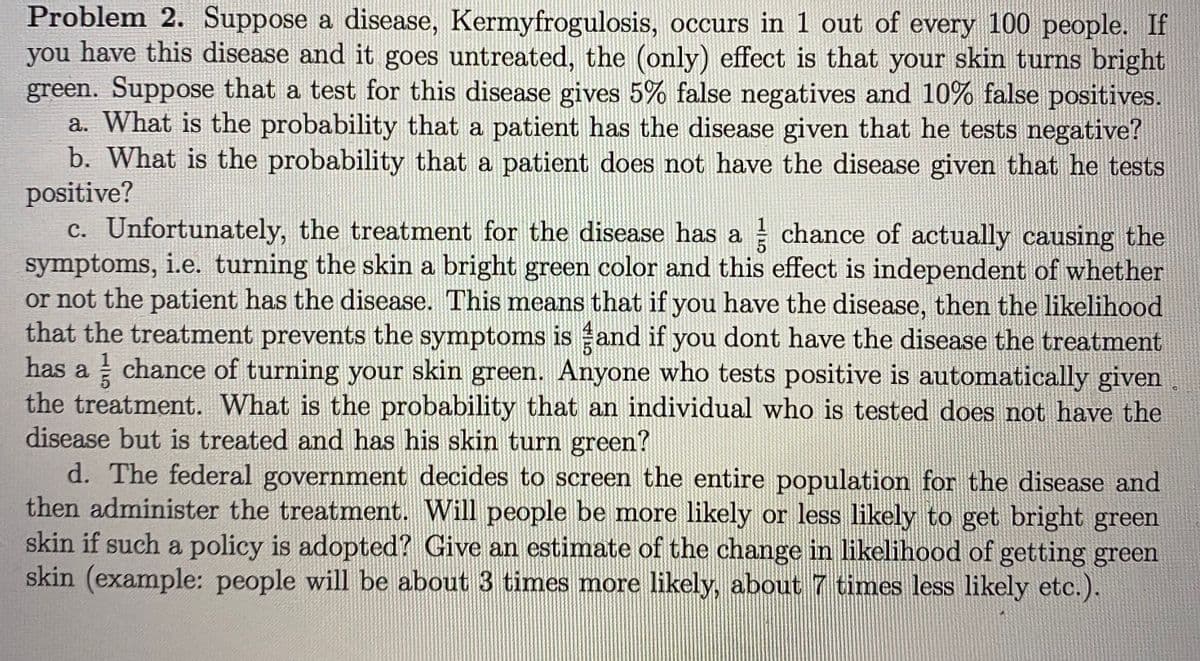Problem 2. Suppose a disease, Kermyfrogulosis, occurs in 1 out of every 100 people. If you have this disease and it goes untreated, the (only) effect is that your skin turns bright green. Suppose that a test for this disease gives 5% false negatives and 10% false positives. a. What is the probability that a patient has the disease given that he tests negative? b. What is the probability that a patient does not have the disease given that he tests positive? c. Unfortunately, the treatment for the disease has a chance of actually causing the symptoms, i.e. turning the skin a bright green color and this effect is independent of whether or not the patient has the disease. This means that if you have the disease, then the likelihood that the treatment prevents the symptoms is and if you dont have the disease the treatment
Problem 2. Suppose a disease, Kermyfrogulosis, occurs in 1 out of every 100 people. If you have this disease and it goes untreated, the (only) effect is that your skin turns bright green. Suppose that a test for this disease gives 5% false negatives and 10% false positives. a. What is the probability that a patient has the disease given that he tests negative? b. What is the probability that a patient does not have the disease given that he tests positive? c. Unfortunately, the treatment for the disease has a chance of actually causing the symptoms, i.e. turning the skin a bright green color and this effect is independent of whether or not the patient has the disease. This means that if you have the disease, then the likelihood that the treatment prevents the symptoms is and if you dont have the disease the treatment
A First Course in Probability (10th Edition)
10th Edition
ISBN:9780134753119
Author:Sheldon Ross
Publisher:Sheldon Ross
Chapter1: Combinatorial Analysis
Section: Chapter Questions
Problem 1.1P: a. How many different 7-place license plates are possible if the first 2 places are for letters and...
Related questions
Question
b-d only please

Transcribed Image Text:Problem 2. Suppose a disease, Kermyfrogulosis, occurs in 1 out of every 100 people. If
you have this disease and it goes untreated, the (only) effect is that your skin turns bright
green. Suppose that a test for this disease gives 5% false negatives and 10% false positives.
a. What is the probability that a patient has the disease given that he tests negative?
b. What is the probability that a patient does not have the disease given that he tests
positive?
c. Unfortunately, the treatment for the disease has a chance of actually causing the
symptoms, i.e. turning the skin a bright green color and this effect is independent of whether
or not the patient has the disease. This means that if you have the disease, then the likelihood
that the treatment prevents the symptoms is and if you dont have the disease the treatment
has a chance of turning your skin green. Anyone who tests positive is automatically given
the treatment. What is the probability that an individual who is tested does not have the
disease but is treated and has his skin turn green?
d. The federal government decides to screen the entire population for the disease and
then administer the treatment. Will people be more likely or less likely to get bright green
skin if such a policy is adopted? Give an estimate of the change in likelihood of getting green
skin (example: people will be about 3 times more likely, about 7 times less likely etc.).
1
Expert Solution
This question has been solved!
Explore an expertly crafted, step-by-step solution for a thorough understanding of key concepts.
Step by step
Solved in 2 steps

Knowledge Booster
Learn more about
Need a deep-dive on the concept behind this application? Look no further. Learn more about this topic, probability and related others by exploring similar questions and additional content below.Recommended textbooks for you

A First Course in Probability (10th Edition)
Probability
ISBN:
9780134753119
Author:
Sheldon Ross
Publisher:
PEARSON


A First Course in Probability (10th Edition)
Probability
ISBN:
9780134753119
Author:
Sheldon Ross
Publisher:
PEARSON
